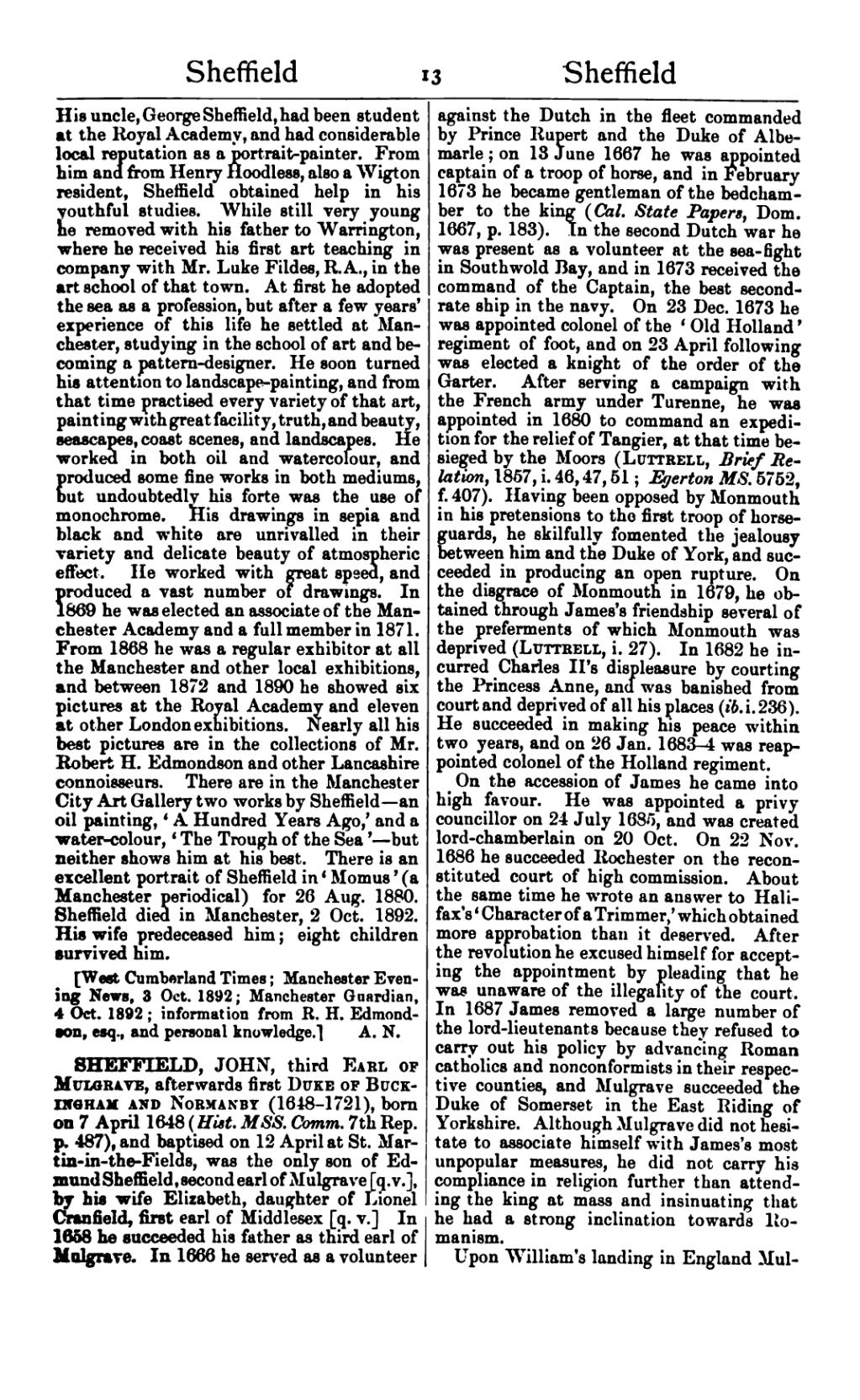His uncle, George Sheffield, had been student at the Royal Academy, and had considerable local reputation as a portrait-painter. From him and from Henry Hoodless, also a Wigton resident, Sheffield obtained help in his youthful studies. While still very young he removed with his father to Warrington, where he received his first art teaching in company with Mr. Luke Fildes, R.A., in the art school of that town. At first he adopted the sea as a profession, but after a few years' experience of this life he settled at Manchester, studying in the school of art and becoming a pattern-designer. He soon turned his attention to landscape-painting, and from that time practised every variety of that art, painting with great facility, truth, and beauty, seascapes, coast scenes, and landscapes. He worked in both oil and watercolour, and produced some fine works in both mediums, but undoubtedly his forte was the use of monochrome. His drawings in sepia and black and white are unrivalled in their variety and delicate beauty of atmospheric effect. He worked with great speed, and produced a vast number of drawings. In 1869 he was elected an associate of the Manchester Academy and a full member in 1871. From 1868 he was a regular exhibitor at all the Manchester and other local exhibitions, and between 1872 and 1890 he showed six pictures at the Royal Academy and eleven at other London exhibitions. Nearly all his best pictures are in the collections of Mr. Robert H. Edmondson and other Lancashire connoisseurs. There are in the Manchester City Art Gallery two works by Sheffield—an oil painting, ‘A Hundred Years Ago,’ and a water-colour, ‘The Trough of the Sea’—but neither shows him at his best. There is an excellent portrait of Sheffield in ‘Momus’ (a Manchester periodical) for 26 Aug. 1880. Sheffield died in Manchester, 2 Oct. 1892. His wife predeceased him; eight children survived him.
[West Cumberland Times; Manchester Evening News, 3 Oct. 1892; Manchester Guardian, 4 Oct. 1892; information from R. H. Edmondson, esq., and personal knowledge.]
SHEFFIELD, JOHN, third Earl of Mulgrave, afterwards first Duke of Buckingham and Normanby (1648–1721), born on 7 April 1648 (Hist. MSS. Comm. 7th Rep. p. 487), and baptised on 12 April at St. Martin-in-the-Fields, was the only son of Edmund Sheffield, second earl of Mulgrave [q. v.], by his wife Elizabeth, daughter of Lionel Cranfield, first earl of Middlesex [q. v.] In 1658 he succeeded his father as third earl of Mulgrave. In 1666 he served as a volunteer against the Dutch in the fleet commanded by Prince Rupert and the Duke of Albemarle; on 13 June 1667 he was appointed captain of a troop of horse, and in February 1673 he became gentleman of the bedchamber to the king (Cal. State Papers, Dom. 1667, p. 183). In the second Dutch war he was present as a volunteer at the sea-fight in Southwold Bay, and in 1673 received the command of the Captain, the best second-rate ship in the navy. On 23 Dec. 1673 he was appointed colonel of the ‘Old Holland’ regiment of foot, and on 23 April following was elected a knight of the order of the Garter. After serving a campaign with the French army under Turenne, he was appointed in 1680 to command an expedition for the relief of Tangier, at that time besieged by the Moors (Luttrell, Brief Relation, 1857 i. 46, 47, 51; Egerton MS. 5752, f. 407). Having been opposed by Monmouth in his pretensions to the first troop of horse-guards, he skilfully fomented the jealousy between him and the Duke of York, and succeeded in producing an open rupture. On the disgrace of Monmouth in 1679, he obtained through James's friendship several of the preferments of which Monmouth was deprived (Luttrell, i. 27). In 1682 he incurred Charles II's displeasure by courting the Princess Anne, and was banished from court and deprived of all his places (ib. i. 236). He succeeded in making his peace within two years, and on 26 Jan. 1683–4 was reappointed colonel of the Holland regiment.
On the accession of James he came into high favour. He was appointed a privy councillor on 24 July 1685, and was created lord-chamberlain on 20 Oct. On 22 Nov. 1686 he succeeded Rochester on the reconstituted court of high commission. About the same time he wrote an answer to Halifax's ‘Character of a Trimmer,’ which obtained more approbation than it deserved. After the revolution he excused himself for accepting the appointment by pleading that he was unaware of the illegality of the court. In 1687 James removed a large number of the lord-lieutenants because they refused to carry out his policy by advancing Roman catholics and nonconformists in their respective counties, and Mulgrave succeeded the Duke of Somerset in the East Riding of Yorkshire. Although Mulgrave did not hesitate to associate himself with James's most unpopular measures, he did not carry his compliance in religion further than attending the king at mass and insinuating that he had a strong inclination towards Romanism.
Upon William's landing in England Mul-

